© The Financial Times Ltd 2016
FT and 'Financial Times' are trademarks of The Financial Times Ltd.
The Financial Times and its journalism are subject to a self-regulation regime under the FT Editorial Code of Practice.
May 3, 2013 2:03 pm
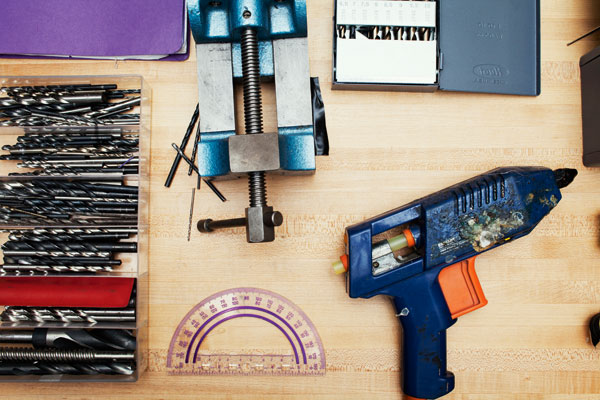 ©Tony Luong
©Tony LuongMIT Media Lab has a strong ‘maker culture’, using old-fashioned tools as well as the latest 3D printers
I start to walk across a street in a city of the near future. An autonomous electric car is gliding silently towards me, driving itself to pick up a group of passengers. The vehicle slows down – but how do I know it will let me cross the road safely?
The robotic car shows it has seen me by swivelling its mobile headlights in my direction. Then its speaker beams a highly directional message at me: “You may cross now.”
This “vehicle-pedestrian interface” is a small but striking example of the wide-ranging City Science initiative under way at MIT Media Lab, the famous interdisciplinary research and design centre at the Massachusetts Institute of Technology.
For 25 years or so after it opened in 1985, Media Lab focused on multimedia computing and communications – the interfaces between people and electronics – and it came up with important new technologies such as the electronic ink used in the Amazon Kindle and Sony Reader. Such research continues to thrive but Media Lab is spreading its academic wings to address broader social issues, says Joi Ito, who became director in 2011 after an unconventional career as an internet entrepreneur and social activist in the US and Japan.
It is also spreading its physical footprint on the edge of the MIT campus, one block in from the Charles River that separates Cambridge from Boston. An extension designed by Fumihiko Maki of Tokyo recently opened alongside the original 1985 building by I.M. Pei, the great Chinese-American architect – doubling its area.
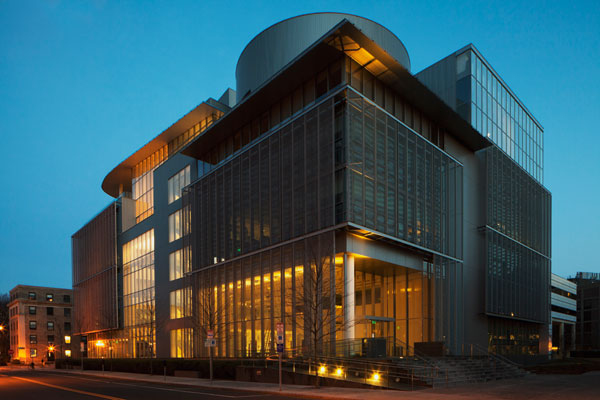 ©Tony Luong
©Tony LuongMedia Lab’s twin buildings, by I.M. Pei and Fumihiko Maki
Both buildings are strikingly bright and open, with plenty of natural lighting and large public spaces. When I arrive at 9am all is quiet but activity builds up during the day – MIT researchers are late starters and late finishers. By lunchtime the lab’s shared spaces host a lively mixture of people, dressed in the casual attire of 21st-century science; some are chatting, others tapping at various model devices.
There is a wide range of ages but the milieu is mainly male; Ito tells me that only 20 per cent of Media Lab faculty members are women. There are plenty of Asian faces but very few African-Americans. In other words, Media Lab has the gender and racial imbalance sadly still typical of elite engineering schools worldwide – and Ito promises to increase diversity.
We talk over a takeaway lunch from Boston’s Legal Sea Foods restaurant chain, his favoured supplier, in an open meeting room. Ito, 46, does not have a private office.
 ©Tony Luong
©Tony LuongFrom university drop-out to internet entrepreneur, Joi Ito is now director of the Media Lab
“We want to be anti-disciplinary – which means filling in the white space between disciplines,” he says. “City Science is a great example of something that brings together work from many fields across the lab. When you bring in kids who are interested in architecture, design, transport, energy, urban gardening, mobility and big data, you get a different way of looking at things.”
I had spent the morning with Kent Larson and Ryan Chin, the architects who run City Science. Similar “city of the future” research projects are fashionable in universities and tech companies around the world, as urbanisation gathers pace. What makes the MIT programme unusual is its breadth, they maintain.
“We could not find another city-related initiative that comes at this in such a holistic way, involving design, policy and all fields of technology,” says Larson. “MIT is one of the few places in the world that has expertise covering all the systems in one lab.”
City Science has a “back to the future” philosophy. “We stepped back and looked at the cities where we all like to be – many of them historic European cities,” Larson says. “The cities that work best are the ones organised as they were before the automobile, with small neighbourhoods 1km to 2km in diameter containing almost all the facilities that people need for daily life. So we decided to graft new technology on to the best human settlement patterns from the past.”
The 21st-century version is a “cellular city” with compact, walkable neighbourhoods – as resilient and self-sufficient as possible – connected by public transport and shared vehicles to a wider urban infrastructure.
The key is to move away from private ownership to “an ecology of shared use vehicles”, says Chin. Social factors are already moving in this direction. MIT students do not care about owning things as much as their parents did at the same age.
“Why own a vehicle or even a house, which is an illiquid asset that ties you down?” asks Larson. “Sharing is a much more rational model than the one I grew up with.”
. . .
Robo-Cars
An average private car today is used just 7 per cent of the time. Shared vehicles, which anyone can drive when they need transport, would be used far more intensively – reducing the amount of space required for parking.
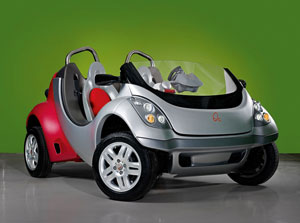 ©Tony Luong
©Tony LuongCityCar, an electric car that folds up to minimise parking space, may be on sale in Europe next year
Media Lab’s answer is the innovation-packed CityCar. It has four independently controlled, electrically powered robotic wheels, which avoids the need for a fixed drive train or axle – and enables the car to “fold up” when parked, giving it a very small footprint.
The first commercial manifestation of the CityCar will be in a place that few would have expected: the Basque region of Spain. An industrial consortium there has made full-scale working prototypes of what it calls Hiriko (Basque for urban car). Hiriko is likely to be on sale in Europe next year, with Deutsche Bahn (German Railways) planning to buy a substantial number for a new electric car-sharing network based on its stations.
Meanwhile Media Lab is working on an autonomous (driverless) version of the CityCar. The first stage will be a car that parks itself after the occupants have got out and then folds up. You could fit five self-parking and folding cars into the space needed for one conventional car. Further ahead is the prospect of cars that can drive themselves for longer distances. “The holy grail is autonomous pick-up and drop-off,” says Larson. “You order a car which drives itself to meet you at your chosen point, with the whole fleet controlled by computer.” The “vehicle-pedestrian interface” mentioned previously is being developed to make people feel safe in the presence of autonomous cars (I experience a static prototype interface – not yet fitted to a moving vehicle).
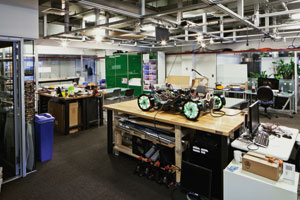 ©Tony Luong
©Tony LuongPrototype of an autonomous vehicle that communicates with pedestrians
A strong strand of architecture and design has run through Media Lab since its foundation by Nicholas Negroponte in 1985. The 27 research groups share seven double-height working spaces, with offices around the perimeter. Sharing stimulates the cross-fertilising of ideas between, for instance, researchers developing “affective” computers that respond to users’ emotions and colleagues creating robotic operas and crowd-sourced symphonies.
There is a strong “maker culture” of building prototypes and machines to test whether research concepts, such as cars recognising pedestrians, work in practice. A vast machine shop houses equipment ranging from hammers and nails to the latest 3D printers, and Media Lab’s private and public spaces are full of interesting objects. For example, a wooden model of a dinosaur gazes across the atrium at a high-tech table football game.
Buildings and their interiors play a key role in the City Science initiative, with a focus on achieving a high quality of life in a confined space through flexibility.
“Young people are the lifeblood of innovation yet they are being priced out of the housing market in many cities,” says Larson. “Mayors recognise that they have to solve the problem of affordable housing and some have been advocating micro-units – but tiny conventional apartments are not the answer because young people don’t want to live there.”
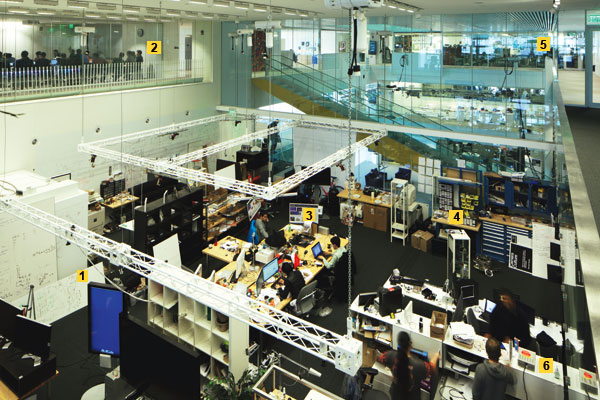 ©Tony Luong
©Tony Luong1. Prototypes. Researchers cover white boards with equations as they build prototypes; 2. Conference room. A graduate seminar is in progress; 3. Thesis writing. Grad student Tiago Lucena puts the finishing touches to his PhD paper; 4. Optoelectronics. Components for building sensors, circuits, lenses and filters; 5. Motorola lab. Home to Fluid Interfaces, High-Low Tech and Responsive Environments research groups; 6. camera culture. Researchers discuss new tools for mobile computer vision
The answer is the “transformable” CityHome. Its robotic walls, furniture and appliances can transform the main room in a small apartment. At night it is a sleeping space with double bed and clothes storage space; during the day and evening it can be used for relaxation or entertainment, with a fully equipped kitchen and dining area.
Media Lab researchers have already demonstrated a prototype RoboWall that lifts and rotates to carry out the transformations. Later this year they plan to build a whole transformable apartment within just 256 sq ft, in collaboration with the local Cambridge city council. Similar technology could produce transformable workplaces that allow businesses to take up less space and consume less energy.
. . .
Air Gardens
The City Science team is also working on ways for the inhabitants of its CityHomes to feed themselves. The answer, at least for fruit and vegetables, is through “aeroponic” urban farming. Plant roots grow in air bags filled with a fine mist of water and nutrients rather than in soil.
 ©Tony Luong
©Tony LuongAeroponic urban farming uses air bags rather than soil. The system may become ‘as ubiquitous as dishwashers'
Jennifer Broutin Farah is developing a computer-controlled aeroponic gardening system called Sprouts IO. “We want to make it really easy for people at home to grow food on a substantial scale for their families,” she says. “Aeroponic growing uses 98 per cent less water and 60 per cent less fertiliser than growing in soil, and it is much lighter in weight.”
Tests show that popular vegetables such as lettuce and tomatoes grow much better in an aeroponic system than in soil. According to Farah, an indoor system illuminated in winter by low-energy LED lights can produce as many as 12 harvests a year.
“We will be doing some user testing over the next few months,” she says. “I see this becoming as ubiquitous as dishwashers in people’s homes.”
 ©Tony Luong
©Tony LuongKent Larson designs cars of the future: ‘The holy grail is autonomous pick-up and drop-off’
At the same time as developing individual components of City Science – including energy networks as well as transport, homes and workplaces – the Media Lab scientists are working on how it all comes together. The discipline of “urban analytics” uses computers to model everything going on in a city for which data are available, while architects and designers plan attractive cityscapes.
“The streetscape should have priority,” says Larson. “That means low-rise buildings along the street, four or five stories high, with taller buildings set further back. You can fit a lot of people into a neighbourhood if they don’t have private cars – and enjoy the positive aspects of high-density living without the negative ones.”
To put ideas from City Science into practice, Media Lab is negotiating partnerships with cities in Asia, Latin America and Africa. “Our goal is to have a relationship with a rapidly urbanising city on each continent,” Larson says. “We want cities with local companies that can commercialise some of the innovations, and local universities will be important too.”
. . .
Lego
Lego will play a role in drawing up cityscapes and presenting them to the public. “Many architects out there still think of Lego as a toy – something beneath them,” says Chin. “But we see Lego models as good not only for urban prototyping but also for involving the public in our designs.”
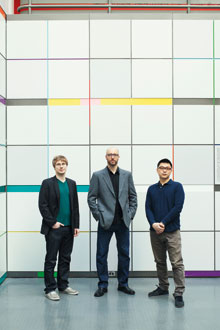 ©Tony Luong
©Tony LuongLego is more than a toy for MIT researchers (from left) Ira Winder, Yaniv Corem and Michael Lin, who use Lego for modelling and prototyping
Yaniv Corem came to Media Lab recently from the IBM Research Lab in Haifa, Israel, to work on the Lego project. “One problem with IBM’s Smarter Cities initiative is that it is disconnected from urban policy makers and the public,” he says. “Lego can help to democratise design. It is simple, cheap and accessible, and many people grew up with Lego.”
Corem will help to integrate Lego modelling with computerised design systems; for example, by putting electronic intelligence into the individual Lego bricks so that they can communicate with each other and a central computer. Then you make a Lego model first and have that translated into a 3D computer model. Or you start from the computer model and get a robot to build it in Lego.
Lego is one of Media Lab’s 80 worldwide “member companies” drawn from a range of industries from electronics to entertainment, aerospace to healthcare, cars to computers. Together they contribute most of the lab’s $35m-a-year operating budget, in a relationship that has no parallel at MIT or elsewhere.
Benefits for corporate members include knowledge transfer, student recruitment and intellectual property. They have the right to license any Media Lab patent granted during their membership period, free of royalties. Non-member companies are precluded from using the lab’s intellectual property for at least two years after a patent has been filed.
Deriving so much income from unrestricted corporate contributions, rather than grants from public funding agencies to carry out projects, gives Media Lab a freedom available to few other academic departments in the US, Ito says. “It enables our faculty to take more risks and be more daring. When you write a grant proposal you know the answer, in a sense, before you start work. Our work can meander in any direction.”
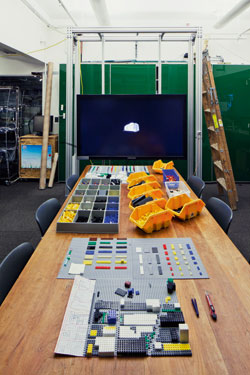 ©Tony Luong
©Tony LuongLegos used to build scaled down models at the MIT Media Lab
The heads of Media Lab’s 27 research teams determine the broad direction of its projects, often working together. For example, City Science is a collaboration between Larson’s group, called Changing Places, and six others, from Human Dynamics to Social Computing.
Then there are more than 50 visiting scientists and postdoctoral researchers and 140 graduate students from around the world. In addition more than 200 of MIT’s brightest undergraduates come to work at Media Lab every year – it is a sought-after undergraduate experience which can give an imaginative push to tiring research projects.
Ito, a softly spoken leader who grew up in the US and Japan and feels at home in both cultures, is not a great fan of the name Media Lab but recognises its brand value.
“I’ve gotten used to it,” he says. “The trouble is that ‘media’ tends to evoke an image of traditional media. But I think of ‘media’ as the plural of medium – a means of expression. Everything we do is about expressing ourselves in new ways. And everything we do should be surprising.”
Ito’s own appointment two years ago was surprising. MIT, a top university, chose as head of its best-known lab someone with a non-academic background who does not even have a first degree to his name. Ito attended classes at Tufts University and the University of Chicago but dropped out of both. Although he has gained a formidable reputation as a thinker and writer about technology and innovation, he appears sensitive to his degreeless status. Last year he declined to attend the MIT commencement (graduation ceremony) because he had no academic robe and felt it would be “grammatically incorrect” to wear a gown.
Ito aims in turn for that element of surprise when the Media Lab appoints new leaders for its research groups. “When we do a faculty search, we’re looking for someone doing something completely unexpected,” he says.
. . .
Bionic Men
Asked to name an amazing current Media Lab researcher, Ito goes for Hugh Herr, head of the biomechatronics group. Herr, a double amputee who lost his legs from severe frostbite following a teenage climbing accident, carries out remarkable research on bionic limbs.
“His idea of extreme bionics is amazing,” Ito says. “It could eliminate any disability and then augment normal human physical capabilities. That really is a bold and audacious goal.”
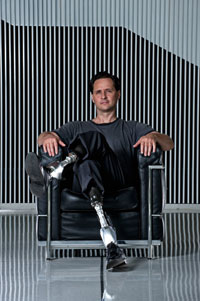 ©Len Rubenstein
©Len RubensteinHugh Herr, biomechanics, doing groundbreaking work on prosthetics
Herr has already made important contributions to prosthetics, including a computer-controlled artificial knee and the world’s first powered ankle-foot prosthesis. His expertise has been in more demand than ever since the Boston Marathon bombings on April 15, which required leg amputation for many victims. But he feels that the field is still in the dark ages: “Fifty years from now people will not believe how primitive today’s implants are.”
An immediate challenge is how to make prosthetic limbs fit comfortably to the body. “The problem I’m going to solve, even if it kills me, is the mechanical interface,” Herr says. “Millions of people are in pain because their prosthesis does not fit well. The greatest bionic limb will fail if you can’t attach it to the body in a comfortable way. If we succeed, that may be my greatest contribution to humanity.”
But Herr is also working on more futuristic projects. “In a decade or two robots attached to the human body will be commonplace,” he predicts. “Synthetic skins, rich in sensation, will stiffen and soften as you walk.”
“The goal is to develop a bidirectional interface, which will transmit information to and from the brain,” Herr adds. “Imagine a future in which you could have sensory feedback from a robotic exoskeleton. Touch something with the prosthesis and you can feel it.”
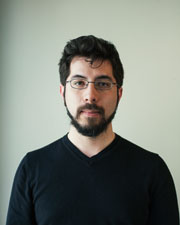 ©Tony Luong
©Tony LuongEd Boyden, neurobiology, creating living mini-brains for research via neural stem cells
Ask Herr in turn about his most remarkable colleague and he mentions one of Media Lab’s most biologically oriented researchers, Ed Boyden, who heads the synthetic neurobiology group. Boyden has a remarkable record of inventing electronic interfaces between the brain and the outside world. He is a leader in optoelectronics, which makes it possible to control brain activity using light – so far only in animals, though clinical trials in patients with neurological disease are not far away. “We are working on roboticising neuroscience, to automate the recording of brain activity,” he says.
One project will use photolithography, a technique borrowed from the semiconductor industry, to build a 3D structure that can be seeded with neural stem cells to create a mini-brain for research. “We want to use mini-brains to study the rules of [neural] wiring, which we don’t understand at the moment,” Boyden says. If the stem cells come from psychiatric patients, this could reveal underlying causes of brain disease and indicate effective treatments.
The technology could even begin to probe the mysteries of consciousness, Boyden says: “With 3D arrays one possibility is to record the activity of very large numbers of brain cells. Maybe we could then understand what happens when a thought occurs.”
From driverless cars that wink their lights at pedestrians to living mini-brains, there is no shortage of ambitious projects at Media Lab. Many will fail to live up to expectations but the lab’s success record suggests that some will transform the way we live and think over the next few decades.
Clive Cookson is the FT’s science editor
Credit: Media Lab researchers Rebecca Kleinberger, Akito Van Troyer and Jie Qi, with support from Alexandra Kahn
Interactive graphic by Caroline Nevitt and Luke Kavanagh. Photograph by Tony Luong
Copyright The Financial Times Limited 2017. You may share using our article tools.
Please don't cut articles from FT.com and redistribute by email or post to the web.
EMAIL BRIEFING

Get our newsletter by email each Saturday. Alec Russell, Weekend FT editor, handpicks a selection of the best life, arts, culture, property and news coverage

